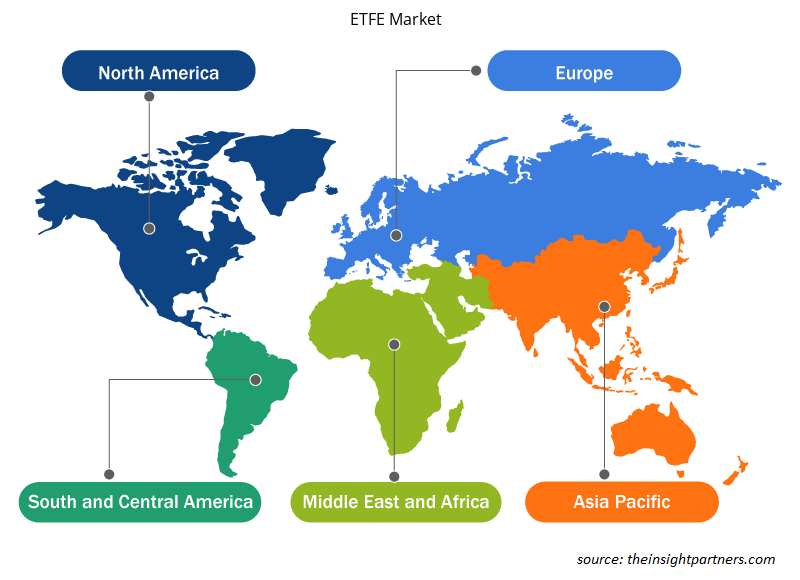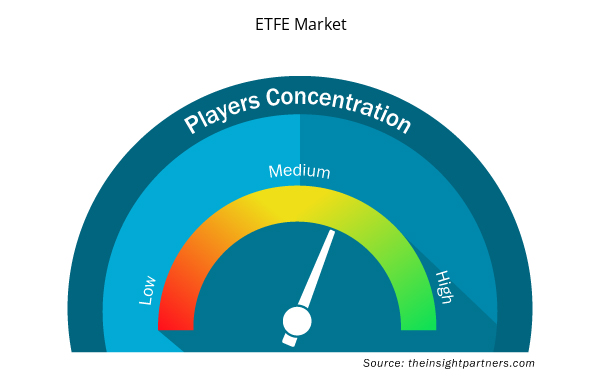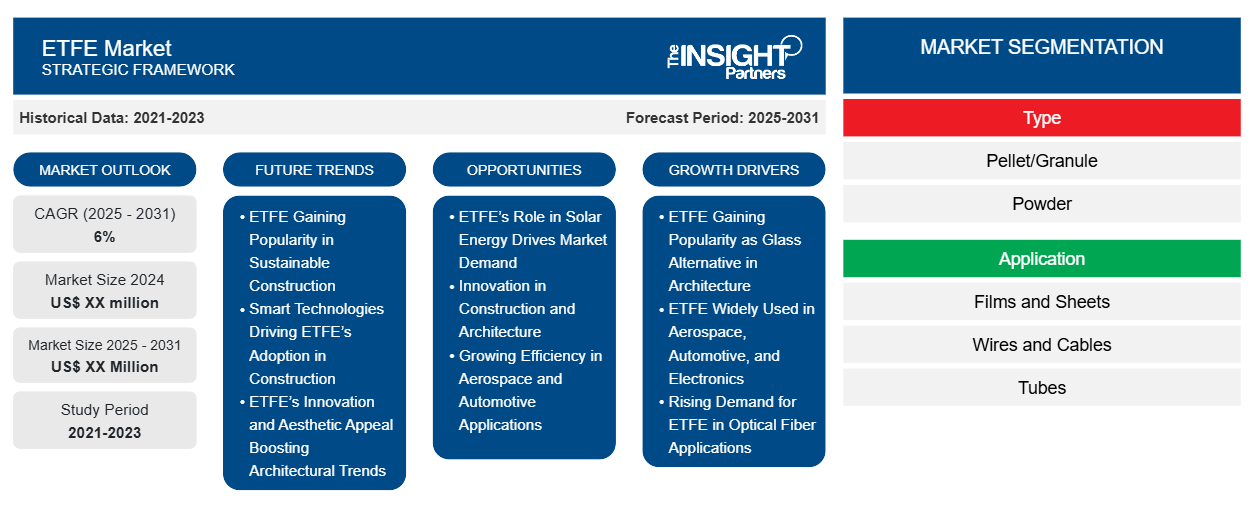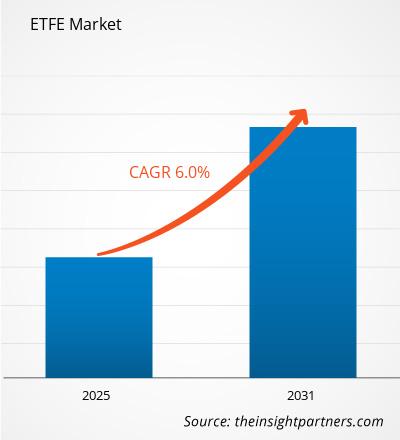Es wird erwartet, dass der ETFE-Markt von 2024 bis 2031 eine durchschnittliche jährliche Wachstumsrate (CAGR) von 6 % verzeichnet und dass die Marktgröße von XX Millionen US-Dollar im Jahr 2024 auf XX Millionen US-Dollar im Jahr 2031 wächst.
Der ETFE-Markt umfasst Analysen nach Typ (Pellet/Granulat, Pulver); Anwendung (Folien und Platten, Drähte und Kabel, Rohre, Beschichtungen, Sonstiges); Technologie (Extrusionsformen, Spritzguss, Sonstiges) und Geografie (Nordamerika, Europa, Asien-Pazifik, Naher Osten und Afrika sowie Süd- und Mittelamerika). Ethylen-Tetrafluorethylen (ETFE), ein fluorbasierter Kunststoff, wurde entwickelt, um eine hohe Korrosionsbeständigkeit und Festigkeit über einen weiten Temperaturbereich hinweg zu bieten. ETFE ist ein Polymer, dessen herkunftsbasierter Name Poly(ethen-co-tetrafluorethen) lautet. ETFE-Folie ist ein mit Teflon verwandter Kunststoffpolymer und wird hergestellt, indem das Polymerharz zu einem dünnen Film extrudiert wird.
Zweck des Berichts
Der Bericht ETFE-Markt von The Insight Partners soll die aktuelle Landschaft und das zukünftige Wachstum sowie die wichtigsten treibenden Faktoren, Herausforderungen und Chancen beschreiben. Dies wird verschiedenen Geschäftspartnern Einblicke geben, wie zum Beispiel:
- Technologieanbieter/-hersteller: Um die sich entwickelnde Marktdynamik zu verstehen und die potenziellen Wachstumschancen zu kennen, damit sie fundierte strategische Entscheidungen treffen können.
- Investoren: Durchführung einer umfassenden Trendanalyse hinsichtlich der Marktwachstumsrate, der finanziellen Marktprognosen und der Chancen entlang der Wertschöpfungskette.
- Regulierungsbehörden: Zur Regulierung von Richtlinien und Überwachungsaktivitäten auf dem Markt mit dem Ziel, Missbrauch zu minimieren, das Vertrauen der Anleger zu bewahren und die Integrität und Stabilität des Marktes aufrechtzuerhalten.
ETFE-Marktsegmentierung
Typ
- Pellet/Granulat
- Pulver
Anwendung
- Folien und Platten
- Drähte und Kabel
- Schläuche
- Beschichtungen
Technologie
- Extrusionsformen
- Spritzguss
Geographie
- Nordamerika
- Europa
- Asien-Pazifik
- Süd- und Mittelamerika
- Naher Osten und Afrika
Passen Sie diesen Bericht Ihren Anforderungen an
Sie erhalten kostenlose Anpassungen an jedem Bericht, einschließlich Teilen dieses Berichts oder einer Analyse auf Länderebene, eines Excel-Datenpakets sowie tolle Angebote und Rabatte für Start-ups und Universitäten.
- Holen Sie sich die wichtigsten Markttrends aus diesem Bericht.Dieses KOSTENLOSE Beispiel umfasst eine Datenanalyse von Markttrends bis hin zu Schätzungen und Prognosen.
Wachstumstreiber auf dem ETFE-Markt
- ETFE wird als Glasalternative in der Architektur immer beliebter: Der größte Wachstumstreiber für den ETFE-Markt ist das Bausegment. Aufgrund seines geringen Gewichts und seiner Langlebigkeit wird ETFE in der Architektur zunehmend als Alternative zu herkömmlichen Anwendungen mit Glas eingesetzt. ETFE eignet sich für Dächer, Fassaden und andere strukturelle Anwendungen, da es eine gute Transparenz aufweist, UV-Strahlungsbeständigkeit bietet und extremen Wetterbedingungen standhält.
- ETFE wird häufig in der Luft- und Raumfahrt, im Automobilbau und in der Elektronik verwendet: ETFE ist einer der robustesten und stärksten Kunststoffe und wird auch außerhalb des Bauwesens häufig verwendet. Es ist hervorragend korrosions-, temperatur- und chemikalienbeständig und wird in der Fahrzeug-, Luft- und Raumfahrt sowie in der Elektronik verwendet.
- Steigende Nachfrage nach ETFE in Glasfaseranwendungen: Neue Anwendungen in Glasfasern, insbesondere als Ummantelungsmaterial, treiben den ETFE-Markt ebenfalls an. In diesem Bereich wird eine Nachfrage im Bereich Telekommunikation und Datenübertragung mit Hochleistungsmaterialien erwartet, was den Einsatz von ETFE weiter steigern sollte.
ETFE-Markt - Zukünftige Trends
- ETFE wird im nachhaltigen Bauen immer beliebter: Das Material wird in der Baubranche in letzter Zeit immer beliebter, da die Branche das Prinzip der Nachhaltigkeit aufgreift. ETFE ist ein leichtes Baumaterial, das die strukturelle Belastung des Gebäudes minimiert. Dadurch wird während des Bauprozesses und durch das Gebäude selbst weniger Energie verbraucht.
- Intelligente Technologien treiben die Einführung von ETFE im Bauwesen voran: Intelligente Technologien im Bauwesen sind die neuen Trends und ETFE ist gut positioniert, um von diesem Wandel zu profitieren. Zukünftige Anwendungen könnten die Integration von Sensoren oder sogar intelligenten Beschichtungen in die ETFE-Folien beinhalten, um Veränderungen in der Umgebung hinsichtlich Temperatur oder Lichtstärke erfassen zu können.
- Innovation und Ästhetik von ETFE beflügeln Architekturtrends: Als innovatives Material mit Funktionalität und ästhetischen Eigenschaften wird ETFE wahrscheinlich die bevorzugte Lösung sein, die Architekten und Designer bei modernen Architekturprojekten in Betracht ziehen. Die anhaltend hohe Bedeutung dieser Merkmale in den Designs wird den Trend zu zunehmenden kreativen Anwendungen bei Gebäudefassaden und Dachsystemen aufrechterhalten.
ETFE-Marktchancen
- Die Rolle von ETFE in der Solarenergie treibt die Marktnachfrage an: Erneuerbare Energiequellen, zu denen auch Solarenergie gehört, stellen einen der Hauptanreize für die wachsende Nachfrage nach ETFE dar. Da ETFE eine hervorragende Lichtdurchlässigkeit bei gleichzeitiger Haltbarkeit gewährleisten kann, wird es im Allgemeinen bei der Herstellung von Solarmodulen verwendet.
- Innovation in Bauwesen und Architektur: Positive Bauaktivitäten und eine starke Betonung von innovativen Baumaterialien machen Nordamerika zum größten ETFE-Verbraucher. Die große Nachfrage nach zeitgenössischer Architektur und umweltfreundlichen Baupraktiken wird in dieser Region auch in naher Zukunft weiterhin ETFE erfordern.
- Steigende Effizienz in der Luft- und Raumfahrt sowie im Automobilbereich: Pfropfen und andere Forschungen und Entwicklungen zu ETFE werden künftig neue Formulierungen hervorbringen, die die mechanischen und thermischen Eigenschaften verbessern. Zukünftige ETFE-Produkte werden voraussichtlich noch widerstandsfähiger gegen extreme Temperaturen, UV-Strahlung und chemische Einflüsse sein, was sie für anspruchsvolle Anwendungen wie die Luft- und Raumfahrt sowie den Automobilbereich noch effizienter macht.
Regionale Einblicke zum ETFE-Markt
Die regionalen Trends und Faktoren, die den ETFE-Markt im Prognosezeitraum beeinflussen, wurden von den Analysten von Insight Partners ausführlich erläutert. In diesem Abschnitt werden auch ETFE-Marktsegmente und -Geografie in Nordamerika, Europa, im asiatisch-pazifischen Raum, im Nahen Osten und Afrika sowie in Süd- und Mittelamerika erörtert.

- Holen Sie sich regionale Daten zum ETFE-Markt
Umfang des ETFE-Marktberichts
| Berichtsattribut | Details |
|---|---|
| Marktgröße im Jahr 2024 | XX Millionen US-Dollar |
| Marktgröße bis 2031 | XX Millionen US-Dollar |
| Globale CAGR (2024 - 2031) | 6 % |
| Historische Daten | 2021-2023 |
| Prognosezeitraum | 2025–2031 |
| Abgedeckte Segmente | Nach Typ
|
| Abgedeckte Regionen und Länder | Nordamerika
|
| Marktführer und wichtige Unternehmensprofile |
|
ETFE-Marktteilnehmerdichte: Der Einfluss auf die Geschäftsdynamik
Der ETFE-Markt wächst rasant, angetrieben durch die steigende Endverbrauchernachfrage aufgrund von Faktoren wie sich entwickelnden Verbraucherpräferenzen, technologischen Fortschritten und einem größeren Bewusstsein für die Vorteile des Produkts. Mit steigender Nachfrage erweitern Unternehmen ihr Angebot, entwickeln Innovationen, um die Bedürfnisse der Verbraucher zu erfüllen, und nutzen neue Trends, was das Marktwachstum weiter ankurbelt.
Die Marktteilnehmerdichte bezieht sich auf die Verteilung von Firmen oder Unternehmen, die in einem bestimmten Markt oder einer bestimmten Branche tätig sind. Sie gibt an, wie viele Wettbewerber (Marktteilnehmer) in einem bestimmten Marktraum im Verhältnis zu seiner Größe oder seinem gesamten Marktwert präsent sind.
Die wichtigsten auf dem ETFE-Markt tätigen Unternehmen sind:
- Asahi Glass Company
- Daikin Industries, Ltd.
- DowDuPont
- Ensinger GmbH
- Guangzhou Lichang Fluoroplastics Co. Ltd.
Haftungsausschluss : Die oben aufgeführten Unternehmen sind nicht in einer bestimmten Reihenfolge aufgeführt.

- Überblick über die wichtigsten Akteure auf dem ETFE-Markt
Wichtige Verkaufsargumente
- Umfassende Abdeckung: Der Bericht deckt die Analyse von Produkten, Dienstleistungen, Typen und Endbenutzern des ETFE-Marktes umfassend ab und bietet einen ganzheitlichen Überblick.
- Expertenanalyse: Der Bericht basiert auf dem umfassenden Verständnis von Branchenexperten und Analysten.
- Aktuelle Informationen: Der Bericht stellt durch die Abdeckung aktueller Informationen und Datentrends Geschäftsrelevanz sicher.
- Anpassungsoptionen: Dieser Bericht kann angepasst werden, um den spezifischen Kundenanforderungen gerecht zu werden und die Geschäftsstrategien optimal anzupassen.
Der Forschungsbericht zum ETFE-Markt kann daher dabei helfen, die Branchensituation und Wachstumsaussichten zu entschlüsseln und zu verstehen. Obwohl es einige berechtigte Bedenken geben kann, überwiegen die allgemeinen Vorteile dieses Berichts tendenziell die Nachteile.
- Historische Analyse (2 Jahre), Basisjahr, Prognose (7 Jahre) mit CAGR
- PEST- und SWOT-Analyse
- Marktgröße Wert/Volumen – Global, Regional, Land
- Branche und Wettbewerbsumfeld
- Excel-Datensatz



Report Coverage
Revenue forecast, Company Analysis, Industry landscape, Growth factors, and Trends

Segment Covered
This text is related
to segments covered.

Regional Scope
North America, Europe, Asia Pacific, Middle East & Africa, South & Central America

Country Scope
This text is related
to country scope.
Häufig gestellte Fragen
The growing construction industry is an emerging trend in the market.
The Asia Pacific market is expected to account for the highest CAGR over the forecast period due to the rising demand of ETFE in the region.
The extrusioon molding technology segment accounted for the largest market share in 2023.
Asahi Glass Company, Daikin Industries,Ltd, Dow, Ensinger GmbH, GuangzhouLichang FluoroplasticsCo.Ltd, HaloPolymer OJSC, Hubei Everflon Polymer Co.Ltd, Quadrant AG(Mitsubishi Chemical Corporation), The Chemours Company, and Vector Foiltec are some of the key players in the market.
The growing demand for ETFE from various application industries is a key driver in the market.
The ETFE Market is estimated to witness a CAGR of 6% from 2023 to 2031
Trends and growth analysis reports related to Chemicals and Materials : READ MORE..
1. Asahi Glass Company
2. Daikin Industries,Ltd.
3. DowDuPont
4. Ensinger GmbH
5. GuangzhouLichang FluoroplasticsCo.Ltd.
6. HaloPolymer OJSC
7. Hubei Everflon Polymer Co.Ltd.
8. Quadrant AG(Mitsubishi Chemical Corporation)
9. The Chemours Company
10. Vector Foiltec
The Insight Partners performs research in 4 major stages: Data Collection & Secondary Research, Primary Research, Data Analysis and Data Triangulation & Final Review.
- Data Collection and Secondary Research:
As a market research and consulting firm operating from a decade, we have published and advised several client across the globe. First step for any study will start with an assessment of currently available data and insights from existing reports. Further, historical and current market information is collected from Investor Presentations, Annual Reports, SEC Filings, etc., and other information related to company’s performance and market positioning are gathered from Paid Databases (Factiva, Hoovers, and Reuters) and various other publications available in public domain.
Several associations trade associates, technical forums, institutes, societies and organization are accessed to gain technical as well as market related insights through their publications such as research papers, blogs and press releases related to the studies are referred to get cues about the market. Further, white papers, journals, magazines, and other news articles published in last 3 years are scrutinized and analyzed to understand the current market trends.
- Primary Research:
The primarily interview analysis comprise of data obtained from industry participants interview and answers to survey questions gathered by in-house primary team.
For primary research, interviews are conducted with industry experts/CEOs/Marketing Managers/VPs/Subject Matter Experts from both demand and supply side to get a 360-degree view of the market. The primary team conducts several interviews based on the complexity of the markets to understand the various market trends and dynamics which makes research more credible and precise.
A typical research interview fulfils the following functions:
- Provides first-hand information on the market size, market trends, growth trends, competitive landscape, and outlook
- Validates and strengthens in-house secondary research findings
- Develops the analysis team’s expertise and market understanding
Primary research involves email interactions and telephone interviews for each market, category, segment, and sub-segment across geographies. The participants who typically take part in such a process include, but are not limited to:
- Industry participants: VPs, business development managers, market intelligence managers and national sales managers
- Outside experts: Valuation experts, research analysts and key opinion leaders specializing in the electronics and semiconductor industry.
Below is the breakup of our primary respondents by company, designation, and region:

Once we receive the confirmation from primary research sources or primary respondents, we finalize the base year market estimation and forecast the data as per the macroeconomic and microeconomic factors assessed during data collection.
- Data Analysis:
Once data is validated through both secondary as well as primary respondents, we finalize the market estimations by hypothesis formulation and factor analysis at regional and country level.
- Macro-Economic Factor Analysis:
We analyse macroeconomic indicators such the gross domestic product (GDP), increase in the demand for goods and services across industries, technological advancement, regional economic growth, governmental policies, the influence of COVID-19, PEST analysis, and other aspects. This analysis aids in setting benchmarks for various nations/regions and approximating market splits. Additionally, the general trend of the aforementioned components aid in determining the market's development possibilities.
- Country Level Data:
Various factors that are especially aligned to the country are taken into account to determine the market size for a certain area and country, including the presence of vendors, such as headquarters and offices, the country's GDP, demand patterns, and industry growth. To comprehend the market dynamics for the nation, a number of growth variables, inhibitors, application areas, and current market trends are researched. The aforementioned elements aid in determining the country's overall market's growth potential.
- Company Profile:
The “Table of Contents” is formulated by listing and analyzing more than 25 - 30 companies operating in the market ecosystem across geographies. However, we profile only 10 companies as a standard practice in our syndicate reports. These 10 companies comprise leading, emerging, and regional players. Nonetheless, our analysis is not restricted to the 10 listed companies, we also analyze other companies present in the market to develop a holistic view and understand the prevailing trends. The “Company Profiles” section in the report covers key facts, business description, products & services, financial information, SWOT analysis, and key developments. The financial information presented is extracted from the annual reports and official documents of the publicly listed companies. Upon collecting the information for the sections of respective companies, we verify them via various primary sources and then compile the data in respective company profiles. The company level information helps us in deriving the base number as well as in forecasting the market size.
- Developing Base Number:
Aggregation of sales statistics (2020-2022) and macro-economic factor, and other secondary and primary research insights are utilized to arrive at base number and related market shares for 2022. The data gaps are identified in this step and relevant market data is analyzed, collected from paid primary interviews or databases. On finalizing the base year market size, forecasts are developed on the basis of macro-economic, industry and market growth factors and company level analysis.
- Data Triangulation and Final Review:
The market findings and base year market size calculations are validated from supply as well as demand side. Demand side validations are based on macro-economic factor analysis and benchmarks for respective regions and countries. In case of supply side validations, revenues of major companies are estimated (in case not available) based on industry benchmark, approximate number of employees, product portfolio, and primary interviews revenues are gathered. Further revenue from target product/service segment is assessed to avoid overshooting of market statistics. In case of heavy deviations between supply and demand side values, all thes steps are repeated to achieve synchronization.
We follow an iterative model, wherein we share our research findings with Subject Matter Experts (SME’s) and Key Opinion Leaders (KOLs) until consensus view of the market is not formulated – this model negates any drastic deviation in the opinions of experts. Only validated and universally acceptable research findings are quoted in our reports.
We have important check points that we use to validate our research findings – which we call – data triangulation, where we validate the information, we generate from secondary sources with primary interviews and then we re-validate with our internal data bases and Subject matter experts. This comprehensive model enables us to deliver high quality, reliable data in shortest possible time.


 Holen Sie sich ein kostenloses Muster für diesen Bericht
Holen Sie sich ein kostenloses Muster für diesen Bericht